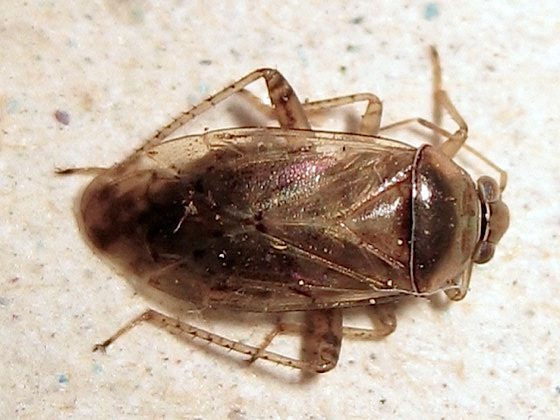Your Garden … with Kate Russell: New pests in Gilroy gardens are damaging artichoke plants
By Kate Russell

California proba bug.
You’ve probably never heard of proba bugs, but they are relatively new pests in Gilroy. And they love artichokes.
Proba bugs (Proba californica) have been around for some time, but they used to prefer coyote brush, which is a common native plant found along highways in agricultural areas of California. At some point (about 1997) a proba bug decided to give artichokes a try. From that moment on, proba bugs have become an increasing threat to artichoke plants.
Adult proba bugs are plain brown and only 0.2 inches long. (That means you could line up 3-1/2 proba bugs across the top of a dime.) Nymphs start out looking like pale yellowish green aphids, except that they move a lot faster than aphids, due to their longer legs. During the next to developmental stages (instars) they are first reddish-brown, and then they develop light and dark bands on the abdominal area during the final two instars.
Proba bugs are active year round (just a lot slower in winter). As temperatures begin to rise, usually in March, they begin feeding and breeding in earnest. Eggs are laid on artichoke petioles (leaf stems) and hatch within 20 to 30 days. Nymphs go through five instars before reaching adulthood.
 The damage caused by proba bugs is similar to that of lygus bugs, only proba bugs are more aggressive in their feeding habits. Adults and nymphs feed on young artichoke leaves and at the base of developing buds. They feed by piercing the tissue and injecting a toxin that kills plant cells. As the surrounding leaf tissue continues to grow, these punctured areas turn into brown dead spots that dry and fall off, leaving a shot hole appearance. Feeding on the base of flower buds causes the bud (the part we eat) to turn black. This phytotoxin also causes stunting and deformed flower buds. Severely affected leaves will be smaller than normal and chlorotic.
The damage caused by proba bugs is similar to that of lygus bugs, only proba bugs are more aggressive in their feeding habits. Adults and nymphs feed on young artichoke leaves and at the base of developing buds. They feed by piercing the tissue and injecting a toxin that kills plant cells. As the surrounding leaf tissue continues to grow, these punctured areas turn into brown dead spots that dry and fall off, leaving a shot hole appearance. Feeding on the base of flower buds causes the bud (the part we eat) to turn black. This phytotoxin also causes stunting and deformed flower buds. Severely affected leaves will be smaller than normal and chlorotic.
Until relatively recently, commercial artichoke fields were treated with organophosphates and chlorinated hydrocarbon insecticides. Use of these neurotoxins is being phased out, so proba bugs are becoming more of a problem. Infested fields can lose 20 to 30 percent of the harvest to proba bugs. Farmers are now removing the coyote brush near their fields and tilling the crop residue under, in a practice called stumping, to help combat this pest.
Natural predators, such as big-eyed bugs, damsel bugs, minute pirate bugs, and spiders all feed on the nymph stage of proba bugs, so avoid using broad-spectrum pesticides.
You can help protect your Gilroy artichoke plants by cutting the plant off at ground level, once flower production is done for the year, and monitoring for signs of infestation in March and April.
Kate Russell is a UCCE Master Gardener in Santa Clara County. For more information, visit www.mgsantaclara.ucanr.edu or call (408) 282-3105 between 9:30 a.m. and 12:30 p.m., Monday through Friday.
